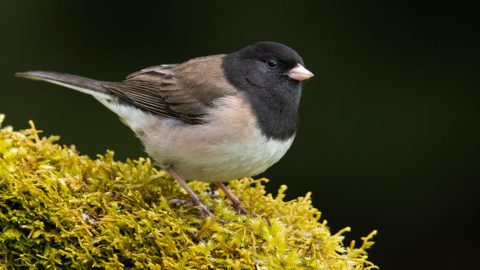Composition in Bird Photography: How to Go Beyond the Portrait
By Marie Read
July 16, 2020Originally posted April 2009; updated July 2020.


A quarter century ago, when being a published bird photographer was still a dream for me, the leader of the local nature photography club, Mike Hopiak, gave me some valuable advice: “A great nature photographer tells you something about your subject, besides how pretty it is.”
Surf through Internet photography forums for bird images, though, and it appears that the goal of many budding bird photographers is still a classic full-frame bird against a clean, out-of-focus background, a style that documents what the bird looks like but little else. Today’s high-tech digital cameras and superb-quality telephoto lenses have made it easier than ever to get excellent bird photographs. On the downside, simple portraits are now a dime a dozen.
To make your bird photographs stand out from the crowd, Mike’s advice is as important as ever. One powerful way to achieve that is to include the bird’s habitat in the photograph. The environmental portrait you’ll produce tells the viewer something about the bird: where and how it lives its life and the way it interacts with, and is influenced by, the place it calls home.
This is great news for those stricken with lens envy or presented with a subject that can’t be approached close enough to fill the frame. Take heart, and turn that limitation to your advantage. Look at the scene as a whole—the bird and its surroundings. Are there elements in the environment, in addition to the main subject, that you can turn into an interesting composition? This is more challenging than a portrait, but the results are well worth the time.

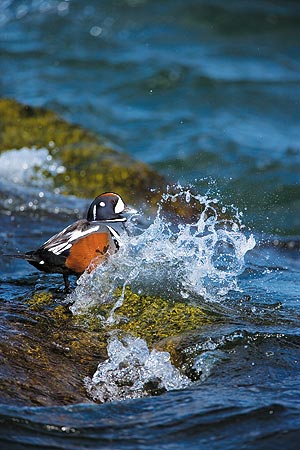
What are the Steps for Good Bird Photography Composition?
Aim for an Image that Conveys Information About the Bird
Consider my experience at Barnegat Light, New Jersey, one recent March. It’s a well-known spot to see wintering Harlequin Ducks and other sea ducks. The harlequins rest at the edge of a long rock jetty, seeing so many birders and photographers that they are fairly easy to approach if one moves slowly. Many portraits of these gorgeous birds have been taken over the years, including some awesome head shots with every feather sharply defined. Stunning though those images are, they tell you little about the bird and the environmental forces with which it contends during its winter sojourn as a marine inhabitant. The Harlequin Duck makes a living by diving to forage in intertidal and subtidal zones, prying crabs, mollusks, and other marine invertebrates from underwater rocks. In doing so, it is exposed to the intense buffeting of the surf against the rocky coastline.


Several days into my trip, I’d already shot the standard stuff: harlequins perched, sleeping, swimming, preening, close-ups—everything that had already been done by numerous photographers before me. Yet I yearned for something more meaningful. Then I noticed one male Harlequin perched on a rock with waves crashing around him, keeping his composure while surrounded by the power of the ocean. Although the bird filled only a small part of the frame, it struck me that this was the situation I was seeking. I began making exposures, timing my shutter release and using a fast shutter speed. I finally nailed one particularly strong wave in mid-crash that surrounded the duck with flying water.

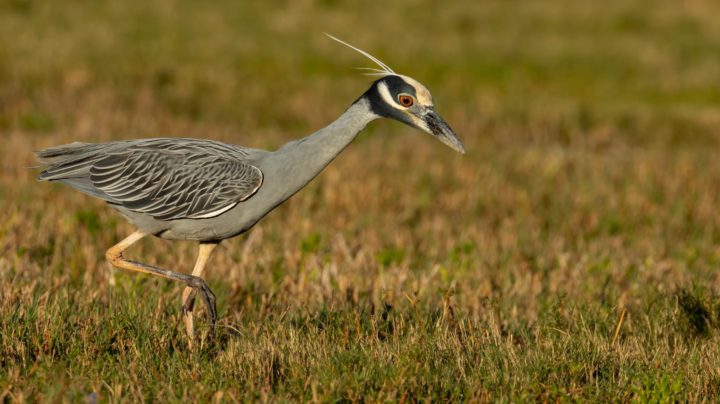
Including habitat in bird photographs offers another plus: the freedom to compose in a more creative way. By its very shape, a frame-filling bird defines the photograph’s orientation, that is, whether it is vertical (portrait) or horizontal (landscape). A full-frame woodpecker on a tree trunk is hard to fit into anything but a vertical format, whereas a swimming duck best fits horizontally. They’re compositional dead-ends. When the birds takes up only a small portion of the frame there are no such constraints. A Yellow-crowned Night-Heron standing tall and straight would best fit a vertical composition, but a more distant view of the bird stalking through a mangrove swamp looking for crabs might look best as a horizontal.
The first thing to remember when the main subject is small is to avoid putting it in the middle of the frame. For a more dynamic design that holds a viewer’s attention, compose with the bird off center. That’s what I did when I found a Sora emerging from a California marsh late one winter afternoon. Looking down from a boardwalk, I was struck as much by the pattern and reflections of cattail leaves in the water as I was by the Sora itself. So I composed the frame with the bird off to one side, using the floating cattails and their reflections as a design element.
Consider the Rule of Thirds


To help you decide where to place an off-center subject, try applying the rule of thirds. Using imaginary lines, roughly divide your frame into three in both the horizontal and vertical planes. Compose so that your bird is located over one of the so-called power points, the places where any two lines intersect. It’s also best to have the bird facing into, not out of, the frame.
If you can include another element—particularly something meaningful to the bird’s lifestyle—as a balance for the main subject, so much the better. Remember, too, that diagonal lines make dramatic designs, so watch for birds perched on diagonal tree limbs and plant stems.
Utilize the Bird’s Environment to Create a Birdscape

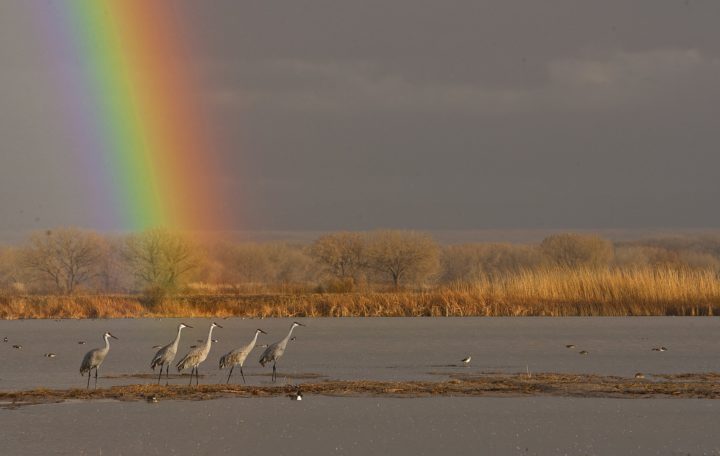
Sometimes nature offers you a stunning landscape in which the individual birds are actually tiny—a flock of birds against an intense sky, a dramatic mountain range, or a beautiful body of water, for instance. Instead of being frustrated because the birds are so distant, try switching to a shorter lens and taking everything in to create a birdscape.
When designing a birdscape, follow the same guidelines that apply to traditional landscape photography. Avoid putting the horizon dead center in the frame. Instead compose with the horizon located either one-third or two-thirds up from the bottom of the frame. Try to use leading lines if they are present, such as those formed by rivers or creeks, to invite the viewer’s eye into and through the frame.
More About Photography
Pay attention to framing your birdscape. It’s best to include something in the foreground as a natural border. If you’re photographing a distant flock of waterbirds, for example, move around to change your perspective so that your composition avoids having the birds so close to the lower edge that they seem to be about to fall out of the frame. Instead, include a rock or a stand of plants in the lower part of the frame as a compositional anchor.
In the absence of anything better, including a narrow strip of bird-free water below the flock will do the job, keeping the birds contained within the image and strengthening the whole composition.
A telephoto zoom lens, such as an 80–200mm, is a great help for critically framing your birdscape if moving closer isn’t possible.
Take Time to Get to Know Your Subject
My final piece of advice is to learn as much as you can about bird life history and avian ecology. That knowledge can help you recognize biologically meaningful situations, thereby influencing your decision about what to include or omit from your frame. One winter, I photographed a male Pileated Woodpecker as it excavated for food in a beech trunk. At first I felt frustrated because, no matter where I moved, dead leaves on an adjacent beech sapling partially obscured the trunk near where the bird was working. Futhermore, a polypore fungus growing through the bark threatened to distract attention from the bird.

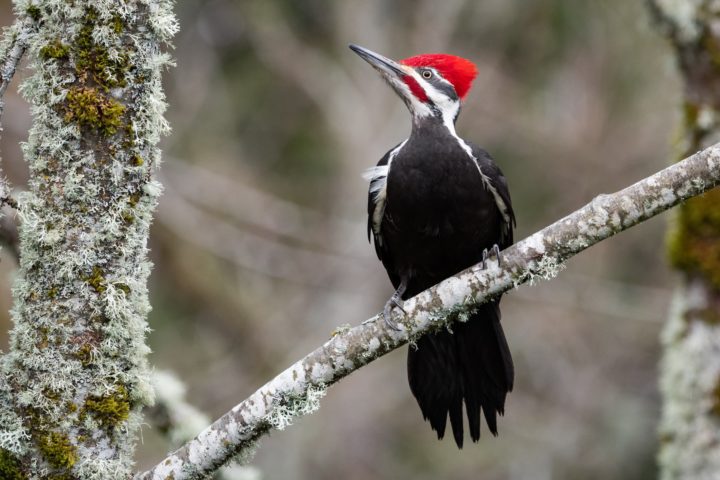
Then I realized that by including all these elements my photograph represented a complex web of ecological interactions. The fungus had caused the beech’s internal decay. The rotting beech wood was infested with carpenter ants, which the woodpecker was exposing with its hammering. Even the dead leaves played a role in identifying the tree species, since beech saplings are unique in that they hold their dead leaves all winter.
Coincidentally, a forestry magazine contacted me a few weeks later searching for a photograph that encompassed these very elements—woodpecker, beech trunk, polypore fungus—for an article about the declining health of beech forests. I was delighted to accommodate them!
So next time you head out to photograph the beauty of birds, don’t forget to include their habitat. Birds don’t live in a vacuum; they live in and interact with their environment. Showing bird-habitat relationship in your photographs is a compelling way to help others understand the fascinating complexity of the natural world. And your pictures will be a cut above the crowd.


All About Birds is a free resource
Available for everyone,
funded by donors like you






